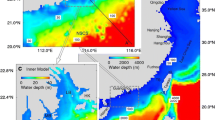Abstract
A three-dimensional, primitive-equation model is developed to study how the Kuroshio, the monsoon, the Yangtze River outflow and the buoyancy forcing from the South China Sea affect the circulation of the East China Sea. It is found that the Kuroshio water usually intrudes into the East China Sea from both sides of Taiwan Island. Winter winds enhance the Kuroshio intrusion from northeast of Taiwan, but weaken it from the Taiwan Strait. Summer winds act in the opposite way. The increased presence of the Kuroshio water in the East China Sea in winter can be largely attributed to the shoreward surface Ekman drift associated with the northerly wind. In summer, theΩ-shaped plume emanating from the Taiwan Strait is, to a large extent, produced by the buoyancy forcing from the South China Sea.
In summer, the bimodal distribution of the Yangtze River outflow is initially produced by the upwelling-favorable wind. Away from the Yangtze River, the far-field dispersal of the fresher water depends on the strength of the Kuroshio. A stronger Kuroshio enhances the seaward dispersal of the northern branch of the Yangtze outflow north of Taiwan, but reduces the southward penetration of the southern branch. In winter, downwelling-favorable winds confine the Yangtze River outflow to a narrow band forming nearshore coastal jet penetrating southward. The northern tip of Taiwan acts as a conduit, channeling the seaward dispersal of the fresher water. The model results interpret the observed circulation patterns.
Similar content being viewed by others
References
Beardsley, R.C., R. Limeburner, H. Yu, and G.A. Cannon (1985): Discharge of the Changjiang (Yangtze River) into the East China Sea. Continental Shelf Res.,4, 57–76.
Blaha, J.P. (1984): Fluctuations of monthly sea level as related to the intensity of the Gulf Stream from Key West to Norfolk. J. Geophys. Res.,89, 8033–8042.
Chao, S.-Y. (1988a): River-forced estuarine plumes. J. Phys. Oceanogr.,18, 72–88.
Chao, S.-Y. (1988b): Wind-driven motion of estuarine plums. J. Phys. Oceanogr.,18, 1144–1166.
Chao, S.-Y. and J.P. McCreary, Jr. (1982): A numerical study of the Kuroshio south of Japan, J. Phys. Oceanogr.,12, 679–693.
Chern, C.-S., J. Wang, and D.-P. Wang (1990): Offshore transport of shelf water at the Kuroshio's edge. J. Geophys. Res., submitted.
Chu, T.-Y. (1976): Study of the Kuroshio current between Taiwan and Ishigakijima. Acta Ocanogr. Taiwanica,6, 1–24.
Chuang, W.-S. (1986): A note on the driving mechanisms of current in the Taiwan Strait, J. Oceaogr. Soc. Japan,42. 355–361.
Fan, K.-L. (1980): On upwelling off northeastern shore of Taiwan. Acta Oceanogr. Taiwanica,11, 105–117.
Guo, B., K. Lin, H. Zuo, and J. Lu (1987): Some features on the circulation in the East China Sea (in Chinese with English abstract). p. 15–32.In: Essays on the Investigation of Kuroshio, ed. by X. Sun, Ocean Press, Beijing.
He, Y. and W. White (1987): Interannual variability of the Kuroshio frontal structure along its western boundary in the North Pacific Ocean associated with the 1982 ENSO event. J. Phys. Oceanogr.,17, 1494–1506.
Kielmann, J. and R.H. Käse (1987): Numerical modeling of meander and eddy formation in the Azores Current frontal zone. J. Phys. Oceanogr.,17, 529–541.
Legler, D.M. and J.J. O'Brien (1984): Atlas of tropical Pacific wind-stress climatology 1971–1980, The Florida State Univ., 182 pp.
McCreary, J.P. and S.-Y. Chao (1985): Three-dimensional shelf circulation along an eastern ocean boundary. J. Mar. Res.,43, 13–36.
Nitnai, H. (1972): Beginning of the Kuroshio. p. 129–156.In Kuroshio: Its Physical Aspects, ed. by H. Stommel and K. Yoshida, Univ. of Washington Press.
Pu, Y., Y. Su and X. Xu (1987): Some features of current field in the south of the East China Sea (in Chinese with English abstract), p. 33–43.In: Essays on the Investigation of Kuroshio, ed. by X. Sun, Ocean Press, Beijing.
Richardson, W.S., W.S. Schmitz and P. Niiler (1969): The velocity structure of the Florida Current from the Florida straits to Cape Fear. Deep-Sea Res.,16, (suppl). 225–231.
Semtner, A.J. (1974): An oceanic general circulation model with bottom topography, Numerical Simulation of Weather and Climate, Tech. Rep. 9, Dept. of Meteorology, UCLA, 99 pp.
Shaw, P.-T. (1989): The intrusion of water masses into the sea southwest of Taiwan. J. Geophys. Res.,94, 18213–18226.
Song, W. (1987): Physical oceanographic features in the Kuroshio mainstream and its adjacent area in the East China Sea during June to July 1984 (in Chinese with English abstract). p. 99–117.In: Essays onthe Investigation of Kuroshio, ed. by X. Sun, Ocean Press, Beijing,
Stern, M.E., J.A. Whitehead and B.-L. Hua (1982): The intrusion of a density current along the coast of a rotating fluid. J. Fluid Mech.,123 237–265.
Sun, X. (1987): Analysis of the surface path of the Kuroshio in the East China Sea (in Chinese with English abstract). p. 1–14.In: Essays on the Investigation of Kuroshio, ed. by X. Sun, Ocean Press, Beijing.
Uda, M. and A. Kishi (1974): Clyclonic cold eddies along the edge of the Kuroshio current in relation to the genesis and passage of cyclones, I. Waters north of Taiwan. p. 199–218.In: The Kuroshio III, Proceedings of the 3rd Symposium, Bangkok, Thailand, 1972.
Wang, Y. (1987): Physical oceanographic features in the Kuroshio mainstream and its adjacent area in the East China Sea during December 1984 to January 1985 (in Chinese with English abstract). p. 133–148.In: Essays on the Investigation of Kuroshio, ed by X. Sun, Ocean Press, Beijing.
Wyrtki, K. (1961): Physical oceanography of the southeast Asia waters. Scientific results of marine investigations of the South China Sea and Gulf of Thailand, 1959–1961. Naga Report, 2, 195 pp.
Zhang, M., J. Yao and J. Chen (1987): Preliminary study about effects of the Kuroshio on the climate of the East China Sea (in Chinese with English abstract). p. 238–246.In: Essays on the Investigation of Kuroshio, ed by X. Sun, Ocean Press, Beijing.
Author information
Authors and Affiliations
Rights and permissions
About this article
Cite this article
Chao, SY. Circulation of the East China Sea, a numerical study. Journal of the Oceanographical Society of Japan 46, 273–295 (1990). https://doi.org/10.1007/BF02123503
Received:
Revised:
Accepted:
Published:
Issue Date:
DOI: https://doi.org/10.1007/BF02123503



